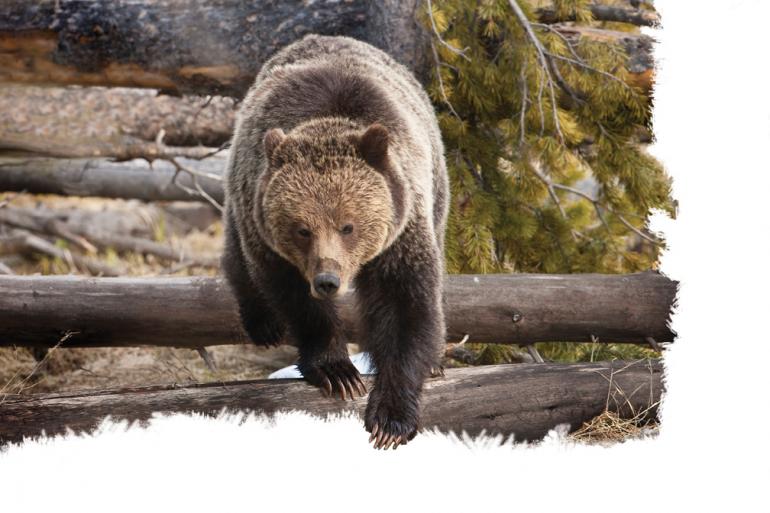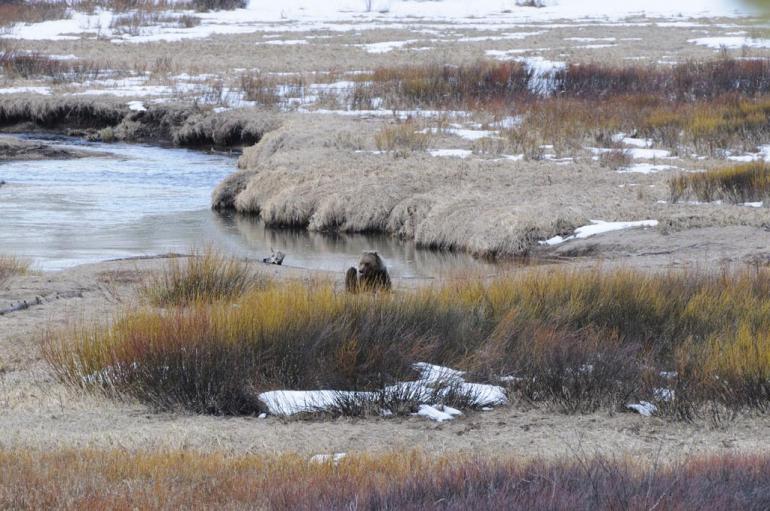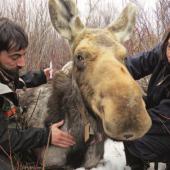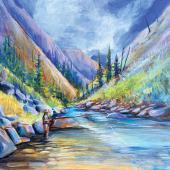Life of the Grizzly
“Tell us a scary bear story.”
I knew what he wanted—I just didn’t want to give it to him.
I had just finished presenting a living history character for an audience at Lone Mountain Ranch. Dressed as a buffalo-hide hunter working for the American Fur Company in the year 1879, I wrapped up the program by coming out of character and bringing folks up to date on the dramatic events that served to shape Montana at the close of the 1800s, like the demise of the bison and the end of native peoples’ dominance of the northern high plains. I also gave a bit of personal background, explaining my time as a ranger in Glacier National Park—which is why he and his two kids came to ask me a particular favor. “C’mon, Greg,” he urged. “Tell us a scary bear story.”
For close to 20 summers, I had worked in Glacier as both Ranger Naturalist and then as a Backcountry/Bear-Management Ranger in the Belly River sub-district in the far northeast corner of the park. My living history character came from my years spent in the park informing visitors about past historical events that would, eventually, create a new national park called Glacier. My years as a backcountry/bear-management ranger had re-affirmed my belief that education is one of the key roles that a ranger can play in a place such as Glacier. I had “talked bears” to literally thousands of backcountry users over the years, and not once did I have to “manage” a bear. Such is bear management, in my opinion, when done correctly. Still, they wanted a story. “C’mon, Greg,” they pressed.
Nope. I didn’t want to give it to them. I wanted to spend a few more quiet moments with my dog Timber, who, as it turns out, would die of old age within a few short weeks. He was my best friend for almost 13 years and we both knew his time was near. I was enjoying the moment and Timber was enjoying the ear scratching and belly rubbing while we sat together, quietly, in the grass around the dying campfire. Evening was coming on. It was getting dark. Still, there they were—requesting a scary bear story.
I took a deep breath. I looked at his two kids. And because of them—a brother and sister no more than eight and ten years of age, respectively—I gave the scariest bear story I knew. And as with many a good story, it begins with these words: Once upon a time…
Once upon a time...
...there lived a six-year-old female grizzly bear. She was a beautiful bear, approaching 300 pounds, mostly chocolate brown with lighter shades of brown dominating her forelegs and her muscular shoulder hump. She lived as all grizzlies do: solitary and alone. Wandering, in her case, the wildest reaches of the Greater Yellowstone Ecosystem. She was fortunate. The great majority of her home range, almost 100 square miles, was situated within Yellowstone National Park. A smaller portion, critical fall range, extended northward into the adjoining Absatoka-Beartooth Wilderness. With the exception of the fall hunting season and the chance encounter with vehicular traffic, she was relatively safe from human interaction. And hence human-caused mortality.
In this, the spring of her sixth year, she had once again become pregnant. She had, for the first time in her life, come into estrus and mated successfully. But her pregnancy was short-lived. A lack of good summer and, more critically, fall nutrition had forced her body to abort the two small clusters of cells that represented the potential for grizzly cubs. A unique process, termed “delayed embryonic implantation,” is utilized by bears to allow them to survive the absence of available calories that presents itself annually over the course of a six-month winter. A successful pregnancy requires a successful feeding season. Last fall, the white-bark pine nut crop, a food source critical to effectively all of Yellowstone’s grizzlies, had failed. In a compromised state—as indicated by her marginal stored fat layer—she had aborted the pregnancy.
So again, this spring, she had come into estrus. She had, through the release of pheromones, attracted three different adult male grizzlies whose home ranges happened to overlap hers. Their big, sensitive noses had scented her available reproductive status, as advertised by the airborne pheromones, from well over a mile away. The three males had postured, fought, and eventually one, a massive 15-year-old boar weighing close to 600 pounds, was chosen. The courtship lasted for several weeks—from late May through the third week in June. This reproductive effort would prove successful in that she would eventually give birth to three small cubs approximately nine months later.
The three cubs, born in the solitude and quiet of the winter den the female had chosen and prepared the following fall, were tiny at birth. Delayed embryonic implantation means that actual fetal growth and development in grizzlies is limited to a four-month window beginning in late fall. As a result, the three cubs, two males and one female, born in the winter den towards the end of January, weighed approximately 16 ounces at birth. One pound. Naked, hairless, and totally dependent upon their mother for the first few months of their lives. That dependency can, in the best of circumstances, last for upwards of three years.
Thus, in a quiet den, near treeline in a remote location in the northern reaches of Yellowstone, it all began for this family group. Upon emergence from the den sometime in early April, the known world for the three cubs expanded exponentially. And so did the potential for trouble. Towards the end May, one of the male cubs was lost to an accident. He drowned while crossing a stream swollen with snowmelt. In late August—the height of the summer tourist season—a car in the Lamar Valley of Yellowstone National Park hit and killed the female cub. The remaining male cub survived the gauntlet of that first year. By late fall, he weighed close to 90 pounds. The sow and her remaining male cub entered a den as a greatly diminished family group at the end of the feeding season in late November.
Once more, with the pull of the spring season, they emerged from the den—this year in mid March. Spring had come early to the northern Rockies. Driven by a relentless hunger, the female and the second-year cub migrated downslope to valley bottoms, which were predictably beginning to free from snow, and more likely to offer up various succulent plants which make up the bulk of any grizzly’s diet. It is late April, and one day, drawn by scent, the female located an elk carcass recently abandoned by a pack of wolves. Unfortunately, it was not immediately clear to her why the carcass had been abandoned. For her and the male cub, it was simply a matter of survival—such an early-season abundance of calories had to be investigated.
In this case, two days earlier, the elk had been killed by wolves. No sooner had they made the kill when a male grizzly moved in and pushed them off. The ten wolves comprising the pack were no match for the big bear. He claimed the kill as his own and defended it with all his abilities. As the sow and cub drew closer, the female could scent his presence. She could not, however, determine his exact location. Cautiously, they moved in to feed on the carcass. It proved a fatal mistake for her surviving cub. The big male grizzly, asleep in a nearby cover of thick vegetation, was quick to respond to this trespass. Moving at close to 30 miles an hour, he covered the 150 yards to the elk carcass in a little over 10 seconds. The young male cub, unable to match the speed and agility of the big boar, was caught from behind. He died instantly with a powerful bite to the neck.
Had the female had time to respond, perhaps she could have intervened and saved her remaining cub’s life. Regardless, her three babies were gone. She was again on her own. Her fate would be determined, as it always is with grizzlies, in her ability to locate adequate calories and stay out of harm’s way. Which, in most cases, means avoiding humans. She might live to be 20 years old and could easily reach 600 pounds. She would, as the spring seasons arrived over the years, periodically come into estrus, attract males, mate, and hopefully produce cubs. In her lifetime, if all went well, a small number of those cubs, perhaps two or three, would survive to become breeding age adults themselves.
“Wow!” exclaimed the daughter. “It’s really hard to be a grizzly bear!” So true—and sadly, it’s getting harder all the time. Grizzlies live their lives within well-defined and relatively rigid biological parameters. In the long-term game of survival, these biological limitations are compounded by today’s modern world. As we sat around the dying campfire, I let the kids do the talking. One after another they brought up the tough issues facing grizzlies. Mostly, we agreed, it boiled down to protecting what is left of grizzly habitat. “It’s simple”, one said, “grizzly bears need a safe place to call home.” Kids—they get it. (Maybe we should let them do the talking more often.) And then, together, they asked a final question. One that could well prove to be the scariest part of the whole story: “Global warming,” they asked, “is that a bad thing for grizzly bears?”
You bet it is, I told them, especially when thrown on top of all the other obstacles they face. Raging rivers, speeding cars, hostile competitors, human encroachment, and now global warming—scary bear story indeed!
Bozeman resident Greg Smith spent 20 years as a ranger in Glacier Park.














